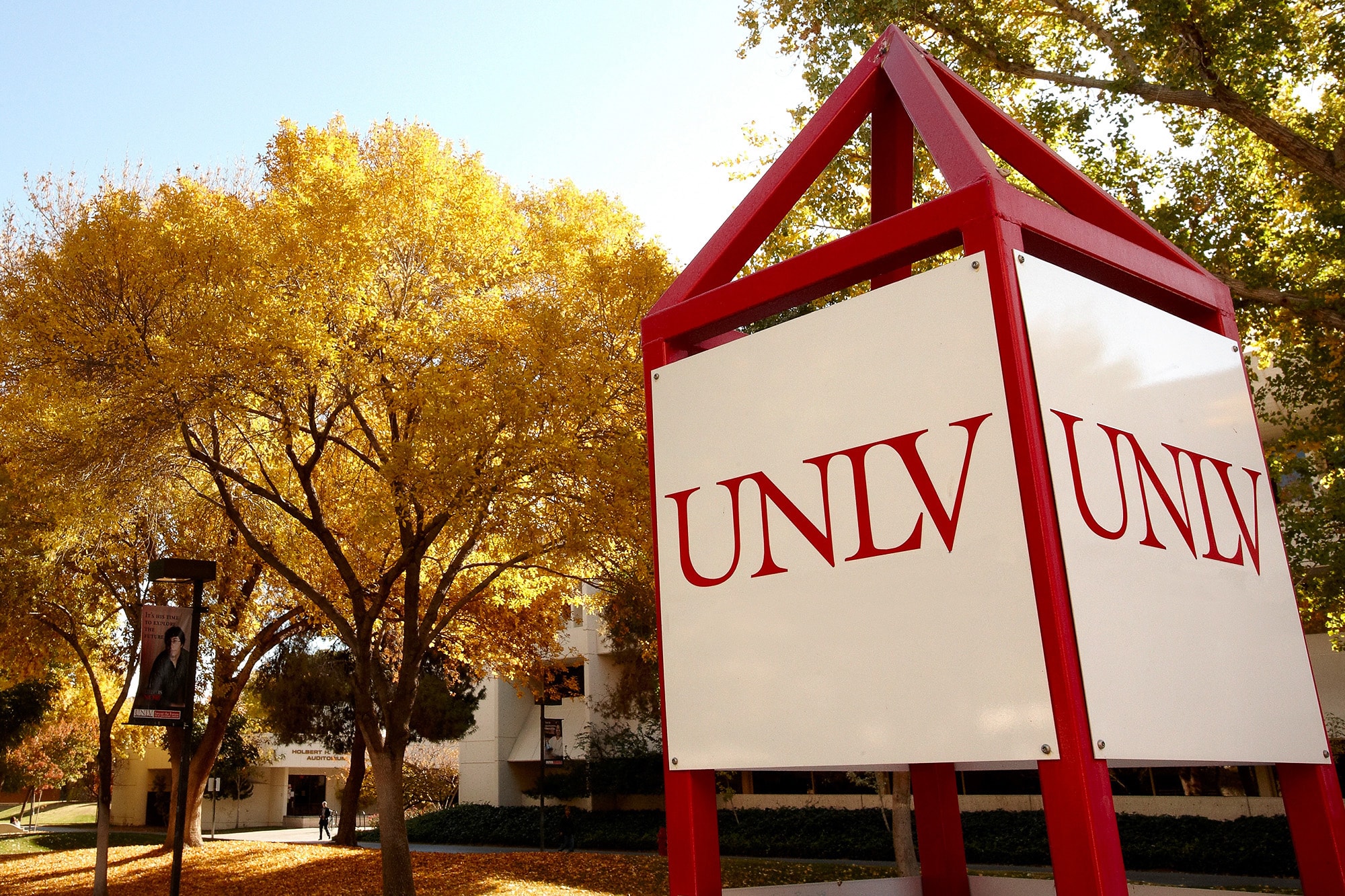UNLV researchers are developing innovations that can help solve real-life problems, and the university is working to help them bring these discoveries to the marketplace.
“There is a great deal of opportunity here,” says Ron Smith, vice president for research and dean of the Graduate College. “UNLV faculty have some wonderful ideas for inventions. Our job is to help them see the commercialization potential of their discoveries and to make companies aware of the work that they are doing.”
The university is seeking to connect faculty with private-sector partners who may be interested in obtaining the licensing rights to these discoveries. Licensing a patented invention or process to a company for commercialization is the traditional way to move technology from the lab to the marketplace. Another way to successfully commercialize a new invention is through the creation of a spin-off company.
Through either scenario, the faculty member, the university, and their private-sector partners can realize benefits.
“This process is advantageous not only for the faculty member, but also for the university; if successful, such innovations could produce significant revenue to all involved, including the institution,” Smith says.
Many UNLV faculty members have produced intellectual property with great commercialization potential and are searching for the right private industry representatives to explore partnership opportunities. Here are just a few of these projects.
Speeding the Mold Detection Process
Patricia Cruz spends her days looking at organisms that the rest of us try to avoid.
An expert in molds, Cruz conducts research on Stachybotrys chartarum – a black mold that thrives in damp or water damaged environments. It poses potentially serious health risks to occupants in contaminated buildings.
The risks from exposure to Stachybotrys chartarum spores can be mitigated by early detection and eradication. But current methods to identify the mold are time consuming and require special expertise.
“Say, for example, that someone suspects this mold exists in a school building,” Cruz explains. “A sample is obtained and is taken to a lab to grow. But many molds don’t like to grow in the laboratory, and even when we can get them to grow on an agar plate, it may take up to 10 days to produce a large enough colony to identify.”
What was needed was a faster way to detect the presence of a mold in a particular sample. So Cruz and her colleagues in the Harry Reid Center for Environmental Studies developed specific polymerase chain reaction (PCR) tests to detect Stachybotrys chartarum and two other molds quickly and definitively.
PCR is a method used by scientists to amplify small pieces of genetic material from a particular sample. All organisms, including microorganisms, contain genetic material unique to that organism. Much like a photocopier, the PCR process copies this unique piece of genetic material millions of times.
“Once the target DNA has been amplified, scientists can identify the organism,” Cruz says.
But for PCR to be useful, the scientist must be certain that the genetic sequence copied is unique to the target organism in question. And this is where the real work began.
With help from her colleague Mark Buttner, Cruz identified the unique bits of DNA that distinguish Stachybotrys chartarum from all other organisms and developed a testing method to detect it. The test could be used by laboratories to quickly identify this particular mold.
“The lab would no longer need to grow a mold colony,” Cruz says. “They could simply extract the DNA out of the spores, do the PCR test, and know by the end of the day if the organism was present and in what amount.”
Because the invention has been patented, commercial or clinical laboratories that are interested in using the invention are invited to enter into a license agreement with UNLV. A patent for detecting a second mold, Aspergillus fumigatus, is being pursued, and Cruz hopes to license the PCR process for detection of this mold as well.
Cruz says the Aspergillus fumigatus mold is particularly problematic for individuals with compromised immune systems, such as burn victims or cancer patients.
“Burn units in hospitals do everything they can to eliminate this organism. Identifying this organism quickly may prevent some of the serious infections that result from exposure,” Cruz says.
Combating Identity Theft
Law enforcement officials may soon have better ways to detect stolen credit card information and verify identity, thanks to a series of innovations developed by UNLV researchers.
These innovations, known as CardSleuth, are the product of a dynamic partnership between Hal Berghel, director of UNLV’s School of Informatics, and the Las Vegas Metropolitan Police Department.
Berghel says the idea for the innovations was born in 2003 when Metro police officers arrested several suspects with large numbers of hotel room keys in their possession.
Then-Metro Deputy Chief Dennis Cobb, a UNLV alumnus, brought the room keys to Berghel, who confirmed that the magnetic stripes on the keys held large amounts of stolen digital credit and debit card information. Cobb then asked Berghel to develop a portable device that officers could use in the field to verify the existence of such information on plastic cards, such as hotel keys or casino player cards.
A partnership grew out of Cobb’s inquiry. UNLV’s School of Informatics soon teamed with the Las Vegas Metropolitan Police Department to establish the Identity Theft and Financial Fraud Research and Operations Center. CardSleuth 1.0, the aforementioned portable device, was the first invention to come from the newly established center.
“Had Dennis not brought the idea to us, we would never have come up with CardSleuth. Academics don’t think like criminals, and law enforcement can’t design computer equipment,” Berghel says. “The magic in this project is that law enforcement can bring a problem to the university, and the team immediately starts working on a technical solution tailored to the crime.”
UNLV filed for a provisional patent on CardSlueuth in 2005. Since then the center has focused its efforts on developing other innovations, including credentialing technology that incorporates biometrics, encryption, holograms, digital photography, and a host of other features into a single, secure form of identification.
Several other patents have been pursued since CardSleuth 1.0, and the technology has garnered private-sector interest. Berghel says he will continue to work collaboratively with Metro to stay one step ahead of the criminals.
“It’s the uncertainty of what technology criminals will use next that provides the thrill in this line of research,” he says.
Manufacturing Nanotechnology
For UNLV engineering professor Biswajit “BJ” Das, creating nanotechnology in the laboratory is not enough.
For the world to reap the benefits of such technology, he believes private industry must be able to manufacture nanoscale structures in much greater numbers.
“Nanotechnology” is a term now commonly used to describe engineering performed at the molecular level. Currently, the tiny particles and structures considered nanotechnology – some of which are 100,000 times smaller than the thickness of a sheet of paper – are produced in the laboratory environment under the supervision of researchers and their graduate students.
However, patent applications are being pursued on a series of processes through which useful nanoscale particles, tubes, and wires can be standardized and mass produced, effectively lowering cost and increasing their availability. The goal, he says, is moving production of these structures from the laboratory to the factory.
With these processes, Das envisions a variety of applications, including improvements to solar power technology, electronic circuitry, and computer memory. He is also seeking a way to make carbon nanotubes more uniform, which will facilitate their use in biomedical applications.
These tiny component parts of equipment can achieve the same functions as larger components, but in a drastically smaller space. The possible applications seem endless.
“Nanotechnology can impact every facet of our lives,” Das says. “In the next 10 years, we will see the biomedical industry directly affected by nanotechnology. And nanotechnology will have an even greater impact on the electronics industry, which reinvents itself constantly.”
In fields such as electronics – where miniaturization of components has become de rigueur – nanotechnology applications are already being developed. But researchers have lacked a way to create uniform structures. When nanoscale structures are all the same size and length, they become more efficient and easier to use in applications. Enter Das and his team.
“We’re engineering the catalyst to make more controlled nanostructures,” says Das. “What people don’t realize is that making the nano is only a small part of it. It has to fit in the whole chain – not the other way around.”
Das hopes that rights to his processes will be acquired by a private-sector partner that will move nanotechnology into the marketplace on a much wider scale.
“There’s so much potential,” Das says. “What drives me now is the desire to see something that I developed become a real product.”
Afsha Bawany contributed to the reporting of this story.



